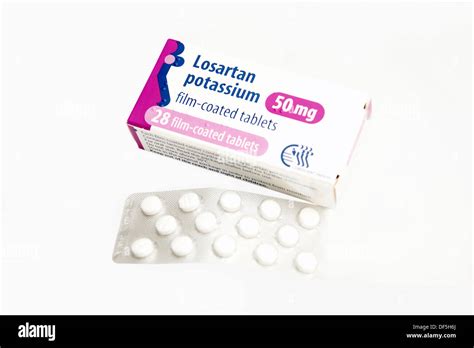Losartan, a medication belonging to the class of drugs known as angiotensin II receptor blockers (ARBs), is primarily used to treat high blood pressure (hypertension) and to protect the kidneys from damage due to diabetes. It works by blocking the action of a natural chemical that narrows blood vessels, allowing blood vessels to widen, which in turn lowers blood pressure and increases the supply of blood and oxygen to the heart.
One of the key benefits of losartan is its ability to reduce the risk of stroke in patients with high blood pressure and left ventricular hypertrophy (a condition where the muscle wall of the heart’s left ventricle becomes thicker than normal). By lowering blood pressure, losartan can also help to reduce the strain on the heart, thereby decreasing the risk of heart failure and other cardiovascular diseases.
In addition to its use in treating high blood pressure, losartan is also used to protect the kidneys in patients with type 2 diabetes. Diabetes can cause damage to the kidneys over time, leading to a condition known as diabetic nephropathy. Losartan has been shown to slow the progression of kidney disease in these patients, reducing the risk of kidney failure and the need for dialysis or a kidney transplant.
Losartan is typically administered orally, once or twice a day, with or without food. The dosage may vary depending on the patient’s condition and how they respond to the medication. It’s essential for patients to follow the dosage instructions provided by their healthcare provider and not to stop taking the medication without consulting their doctor, as suddenly stopping losartan can lead to a rebound effect, causing blood pressure to spike.
While losartan is generally well-tolerated, it can cause side effects in some patients. The most common side effects include dizziness, back pain, and stomach upset. In rare cases, losartan can cause more serious side effects, such as allergic reactions, liver damage, or a condition called hyperkalemia (high levels of potassium in the blood). Patients should seek medical attention immediately if they experience any severe or persistent side effects.
In comparative analysis with other medications used to treat high blood pressure and protect the kidneys, losartan has been shown to be as effective as, if not more effective than, some other ARBs and ACE inhibitors (another class of blood pressure medications). However, the choice of medication depends on various factors, including the patient’s medical history, the presence of other health conditions, and potential interactions with other medications they are taking.
For instance, a historical evolution of the treatment of high blood pressure and diabetic nephropathy shows that the introduction of ARBs like losartan has significantly improved outcomes for patients. Prior to the development of these medications, patients often had limited treatment options, and the risk of complications from high blood pressure and diabetes was much higher. Today, with medications like losartan, healthcare providers can offer more targeted and effective treatments, improving the quality of life for millions of people worldwide.
In conclusion, losartan is a valuable medication for managing high blood pressure and protecting the kidneys in patients with diabetes. Its ability to block the action of angiotensin II, a potent vasoconstrictor, makes it an effective tool in the prevention of stroke, heart failure, and kidney disease. As with any medication, it’s crucial for patients to work closely with their healthcare provider to determine the best course of treatment and to monitor for any potential side effects.
FAQ Section
What are the most common side effects of losartan?
+The most common side effects of losartan include dizziness, back pain, and stomach upset. However, these side effects are generally mild and temporary.
Can losartan be used in patients with kidney disease?
+Yes, losartan can be used in patients with kidney disease, particularly those with diabetic nephropathy. It has been shown to slow the progression of kidney disease in these patients.
How long does it take for losartan to start working?
+Losartan can start to lower blood pressure within a few weeks of starting treatment, but it may take several months to achieve its full effect.
Can I stop taking losartan if my blood pressure is under control?
+No, you should not stop taking losartan without consulting your healthcare provider. Suddenly stopping losartan can cause a rebound effect, leading to a spike in blood pressure.
The future trends in the treatment of high blood pressure and diabetic nephropathy are likely to involve the development of more targeted and personalized therapies. With advancements in genetic research and precision medicine, healthcare providers may soon be able to tailor treatment plans to an individual’s specific genetic profile and medical history, leading to more effective and sustainable outcomes. Additionally, the integration of digital health technologies, such as telemedicine and mobile health applications, is expected to improve patient engagement and adherence to treatment, further enhancing the management of these conditions.
In technical breakdown, losartan’s mechanism of action involves the selective blockade of the angiotensin II type 1 (AT1) receptor, which is responsible for the vasoconstrictive and aldosterone-secreting effects of angiotensin II. By blocking this receptor, losartan reduces the levels of angiotensin II, leading to vasodilation and a subsequent decrease in blood pressure. This complex process highlights the importance of understanding the underlying physiological mechanisms in the development of effective treatments for hypertension and related conditions.
As the field of cardiovascular medicine continues to evolve, it’s essential for healthcare providers and patients to stay informed about the latest developments and advancements in the treatment of high blood pressure and diabetic nephropathy. By working together and leveraging the latest research and technologies, we can improve outcomes and enhance the quality of life for those affected by these conditions.



